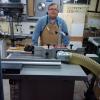
Originally Posted by
Alex Zeller

If it was me I would think long and hard about what tools you plan on owning. For example a 5hp 20" 4 post planer is going to draw 25 amps, but not at start up. It'll likely draw more than 30 for a brief moment. Grizzy says a 30 amp is enough while Powermatic says a 40 amp is needed. Are you going to have a jointer and planer, a combo machine, or neither? If you are going to have two separate machines then you may want to use them at the same time. With only one 240v outlet you will be plugging and unplugging tools (and forgetting until you push the ON button and nothing happens). If you have a lunch box planer now are you going to keep it for the life of this shop or are their plans in the future to get something quieter? Chances are that'll be 240v. I have 3 240v outlets in my basement shop. Two are 30 amp and the third is 40 amp. The 40 amp circuit has a 30 amp twist lock outlet and right next to it a 20 amp flat blade style outlet so I can use one or the other. The two 30 amp circuits have just the flat blade style 20 amp outlets. But the correct size wire to handle the maximum power the breaker will allow must be used. That way I'm future proofed if I need to add larger outlets.
Alex, I don’t think this is code compliant. Both the wiring and devices must be protected. Code says the receptacle must match the over current protection. As far as I can tell, the only exception is 15 amp outlets on a 20 amp circuit with the proviso that it is not the only outlet on the circuit (a duplex receptacle is considered two).
Edit: welders are an exception, too. You can put a 50 amp receptacle on a 40 amp circuit, but you can’t put a smaller receptacle on it.
Last edited by Charlie Velasquez; 08-21-2020 at 8:23 PM.
Reason: double negative
Comments made here are my own and, according to my children, do not reflect the opinions of any other person... anywhere, anytime.




 Reply With Quote
Reply With Quote


